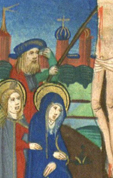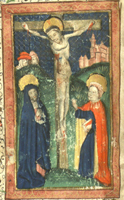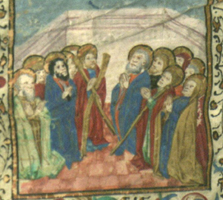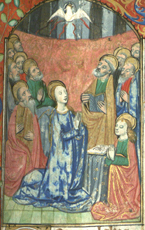Other Hours
Passion Narratives
The Hours of the Cross and the Hours of the Holy Spirit provided other opportunities for prayer, emphasizing Christ’s passion and the role of the Holy Spirit during and after the life of Christ, respectively. These hours were secondary to the Hours of the Virgin and reflected a movement in private devotion towards meditation on embellished Gospel narratives.
The prayers in the Hours of the Cross focus on the story of Christ’s Passion, beginning at Matins with a hymn describing Judas' betrayal of Christ and ending at Compline with a hymn describing Christ’s entombment. The Hours of the Cross correspond to the supposed hours at which each stage of the Passion occurred, inviting the reader to emotionally relive the story of Christ's sacrifice.
Theme and Variations
A miniature of the Crucifixion usually accompanied the Hours of the Cross. At the center of the Crucifixion scene is the body of Christ, often enlarged relative to other figures and noticeably dripping blood. Christ’s wounds may have been viewed as a sacred entrance into his dually human and divine flesh. Pools of blood beneath the cross reminded readers of the sacrament of the Eucharist and the miraculous power of Christ's blood, often the subject of saintly miracles. The gruesome events addressed in the Hours of the Cross stimulated intense empathetic feelings in the devout reader.
The Mongan Hours, which uses the Passion Cycle within the Hours  of the Virgin later in the book, begins with the Hours of the Holy Cross. Christ on the Cross is flanked by the Virgin and St. John, into whose care Christ commended Mary after his death. Other characters from the Biblical texts and from apocryphal accounts are sometimes present in these images as well. In the Castle Hours 3, Mary Magdalene attends the Virgin. The nearly-blind centurion, Longinus, points to his eyes as he miraculously recovers his vision and is converted at the moment he pierces Christ's side with his spear. Longinus is often represented as an everyman, appealing to medieval viewers who would also gain new clarity and religious understanding by meditating on this image
of the Virgin later in the book, begins with the Hours of the Holy Cross. Christ on the Cross is flanked by the Virgin and St. John, into whose care Christ commended Mary after his death. Other characters from the Biblical texts and from apocryphal accounts are sometimes present in these images as well. In the Castle Hours 3, Mary Magdalene attends the Virgin. The nearly-blind centurion, Longinus, points to his eyes as he miraculously recovers his vision and is converted at the moment he pierces Christ's side with his spear. Longinus is often represented as an everyman, appealing to medieval viewers who would also gain new clarity and religious understanding by meditating on this image
Moments of Revelation
The Office of the Holy Spirit similarly recounts a story for the reader, beginning at Matins with the Incarnation - the point at which God sent the Holy Spirit to Mary to conceive the Christ Child - continuing at Terce with Pentecost, and ending at Compline with an allusion to the Last Judgment. The Hours of the Holy Spirit are typically accompanied by a miniature of the Pentecost, two versions of which are shown here. In the more orthodox depiction the twelve apostles are gathered within a walled space. The Holy Spirit comes down from heaven and grants them the ability to speak in tongues and to prophesy.In the illustration of Pentecost from the Castle Hours 2, the Virgin is the central figure, even though she does not appear in the biblical version of the story. And yet this is not an unusual depiction. The discrepancy stems from the relative absence of information about Mary in the Bible. Her increasing importance in popular devotion was accompanied by the creation of a rich body of Marian texts, narrating her childhood and inserting her into important biblical events. Both Mary and one of the apostles are using books in prayer at the moment of the descent of the Holy Spirit in this image, modeling their use by laypeople to prepare for their own moments of religious revelation.




